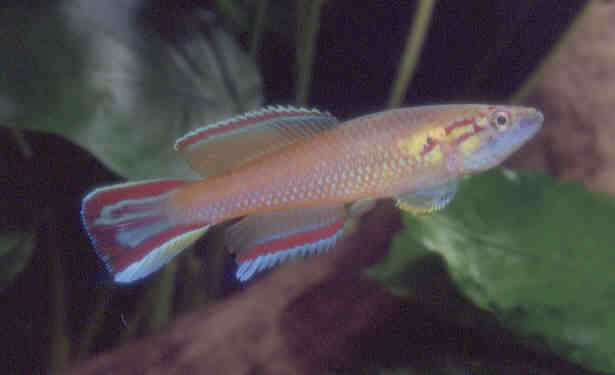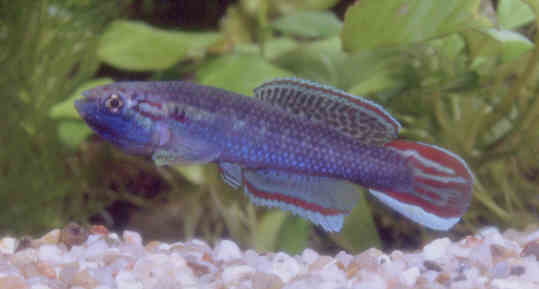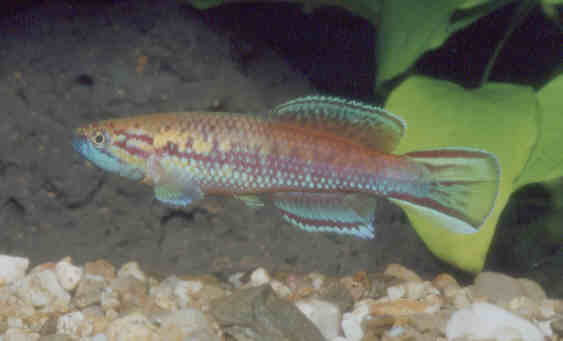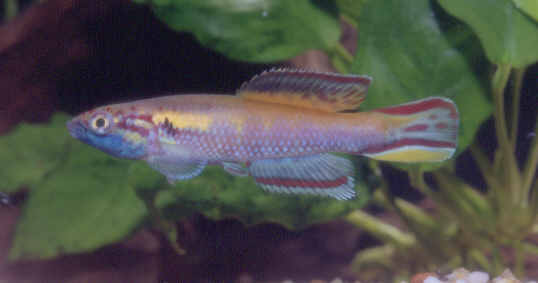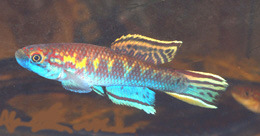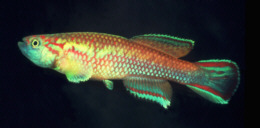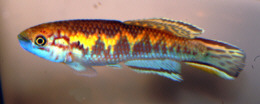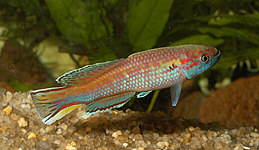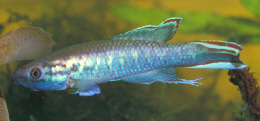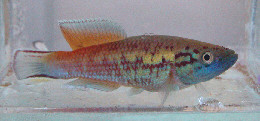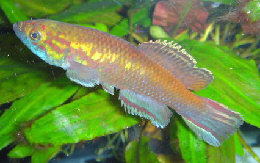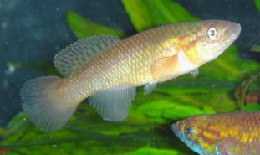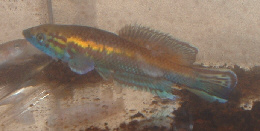Callopanchax occidentalis (Clausen 1966)
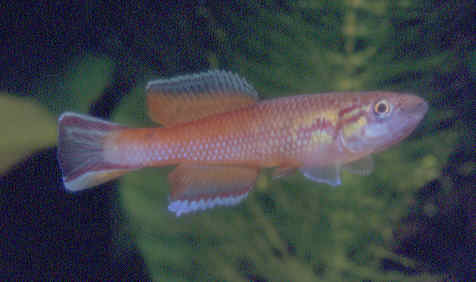
Call.occidentalis. Photo courtesy of Ed Pürzl.
| Meaning of Name |
'West' -referring to West Africa. |
||||||||||||||||||||||
| First Description |
Aphyosemion occidentale
Clausen, H. S. 1966 Revue de Zoologie et de Botanique Africaines v. 74 (pts 3-4): 331-341. |
||||||||||||||||||||||
| Size |
8 cm (Scheel ROTOW2 - 7cm) |
||||||||||||||||||||||
| Meristics |
|
||||||||||||||||||||||
| Karyotype |
n=23 A=46 |
||||||||||||||||||||||
| Sub-Genus | |||||||||||||||||||||||
| Group | |||||||||||||||||||||||
| Synonyms |
|
||||||||||||||||||||||
Populations
|
|
||||||||||||||||||||||
| Type Locality |
Blama, Sierra Leone. |
||||||||||||||||||||||
| Distribution |
Central & eastern Sierra Leone & extreme northwest Liberia. Replaced westerly by toddi & easterly by monroviae. |
||||||||||||||||||||||
| Habitat |
|
||||||||||||||||||||||
| Distinguishing Characteristics | |||||||||||||||||||||||
| Colour/Pattern Variability | |||||||||||||||||||||||
| History |
First reports of this species come from 1909 when, on the 9th of June Grote, a German aquarist from Hamburg whilst serving on a German ship collected fish from Sherboro Island off the coast of Sierra Leone & south of Freetown. Some of these fish were brought alive back to Hamburg. Arnold reports being offered some colourful Fundulus by an unknown individual which were collected on Sherboro Island. The aquarium society which Grote belonged to reported that they had been shown this fish on the 26th of October 1909. Arnold saw these fish at Memmler's house in November 1909 & these were shown at an aquarium exhibition in Hamburg in December 1909. Memmler's original fish died in February 1910 & these were preserved & sent to Arnold. Around 1910, Arnold sent these to Boulenger in London who identified them as sjoestedti. In January 1911 more fish were imported. Gellner
described & pictured them as 'Red Fundulus'
or 'Fundulus Syostedtie?' He stated
that this material came from the Gold Coast (now Ghana). Although his
description of the fish was not very complete it was clearly identifiable
with the earlier import from Sherboro Island. A month later Arnold used
these fish to describe & figure sjoestedti.
Rachow also described & illustrated this fish as sjoestedti
in 1911. The fish used by Mayer to photograph were said to have been
collected at Axim, Gold Coast. Boulenger, in 1915, redescribed Löennberg's sjoestedti but the preserved material he partly used in this redescription were probably not true sjoestedti but occidentale or batesii. Still in 1915, Boulenger referred to occidentale as sjoestedti in a collection of fish collected by Thomas in 1913 from Matca, Sierra Leone. The name coeruleum was used widely for these fish from 1915. 1962, collected by Roloff at Magbenta, near Rokel, Sierra Leone & Blama, east, Sierra Leone. Collected by Schiötz in 1963 at Kasewi, Sierra Leone. Clausen, in 1966, described Aphyosemion occidentale using the preserved specimens collected by Grote in 1909. In 1969 Roloff rediscovered occidentale at Magbenta, near Rokel, central Sierra Leone & also near Blama situated in the east of Sierra Leone. Some of these two populations were given to Scheel for study. Schiötz also collected them at Kasewe & Makeni, central Sierra Leone. |
||||||||||||||||||||||
| Breeding Notes |
Gellner, in 1911, reported using sand as a substrate & showed that eggs would be buried about 1 cm deep. Also noted was eggs incubated at 23°C showed no development after 8 weeks. Scheel's experiments in ROTOW 1 showed that eggs layed in 'fine & dirty mud' & kept under anaerobic conditions for 'some weeks', later to be washed & placed in clean, slightly acid water with a zero hardness in open containers maintained at 22-23°C gave the following data.
Gellner in 1911 reported a pair layed eggs 1 cm deep in sand. Eggs were observed to show no development at 8 weeks. The reference in ROTOW2 doesn't say if these were stored in water or not but they probably were. Temperature maintained at was 23°C. Scheel again in ROTOW2 reported maintaining eggs for 273 days in slightly moist peat & hatched fully viable fry. Other experiments were undertaken & he determined that diapause 1 lasted for around 50 days. A breeding report appeared in BKA newsletter
No.79, March 1972 by Bob Schwiegerath. Bob had no success in spawning
them in mops & used a tray of 'glass beads' as a receptacle for
the eggs. He harvested about 80 eggs every 3 days by using this method.
Eggs were placed in a tray with water from the parents tank with a little
Acriflavine. Eggs which turned white were removed & those still
healthy after 3 days were placed in preboiled peat moss. Some of these
eggs were left in water to incubate until hatching. This took almost
7 months. A month before this some micro worm was added to the water.
At this stage little or no embryonation was observed. They were reported
to 'suddenly embryonate'. Newly hatched fry were weak on hatching &
were transferred to a 10 gallon tank with a little salt added. Dick Aylott in BKA newsletter No.198, February
1982 found a bag of peat in his fish house which was 12 months past
its hatching date & dry as dust. He wet them & reported a good
hatch. Tony Pinto in BKA newsletter No.237, May 1985
found that the best temperature to maintain them was 72-75°F as
at higher temperatures the fish showed signs of aging at 6 months. The
fish were tolerant of temperature in the low 60°'s but were more
susceptible to velvet & other infections. |
||||||||||||||||||||||
| Diameter of Egg | 1·4 - 1·5 mm, clear & golden in colour. | ||||||||||||||||||||||
| Remarks |
This is a very old species & may represent an ancient form from which Aphyosemion & other genera may have evolved. |
